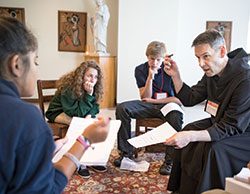2019 Vocations Awareness Supplement
Saint Meinrad Archabbey: A Path to God’s Kingdom

Benedictine Brother John Mark Falkenhain leads a discussion during a session of One Bread One Cup, a summer youth liturgical leadership conference held by Saint Meinrad Seminary and School of Theology. (Photo courtesy of Saint Meinrad Archabbey)
By Br. Zachary Wilberding, O.S.B. (Special to The Criterion)
ST. MEINRAD—In chilly predawn darkness, bells ring out over the forested hills of Spencer County in southern Indiana.
It’s 5:15 in the morning. The bells are calling the Benedictine monks of Saint Meinrad Archabbey to their first prayer service of the day, which is known as the Office of Vigils.
Monks silently make their way to their church for this service that symbolizes their keeping close watch for the return of Christ. It will be closely followed by the Office of Lauds (also known as Morning Prayer), which is sung praise for the dawning of a new day.
The purpose of a monk’s life is to seek God. Prayer together in common and alone in private is essential. The monks pray together as a community six times a day. They celebrate Mass daily as the source and summit of the Christian life. There are five services which make up what are called the Liturgy of the Hours: Vigils, Lauds, Midday Prayer, Vespers and Compline (also known as Night Prayer).
These are composed largely of Scripture, primarily the psalms, some of which are sung to Gregorian chant. Taking this time for formal prayer helps the monks to make their entire life a prayer.
The private prayer of the monks is called Lectio Divina. There are two periods in the daily schedule for this. Lectio Divina is Latin for sacred reading and is an ancient Christian practice of reading and meditating on Scripture as a way of listening for what God has to say to the monk. For monks, Scripture is an inexhaustible source of spiritual nourishment, a well that never runs dry.
To better foster a life of prayer, silence is kept most of the time in the monastery. But there are also times of recreation and relaxation when the monks gather to share news and anecdotes and play games.
Chess and sequence are two popular games, and a few monks play catch in the monastery’s front yard. A sister visiting the monastery recently observed the evening game of catch and commented that the abbot “still has his arm.”
Life at Saint Meinrad is guided by the Rule of St. Benedict. He was a sixth-century Italian monk who tried to make a holy life accessible to ordinary people.
Benedict believed that the monastery should be so organized that, in words found in his Rule, “the strong have something to yearn for and the weak nothing to run from.”
In accord with the Rule, the prayer of the monks bears fruit in various types of work. Several monks are involved in teaching and administration in Saint Meinrad Seminary and School of Theology. Some monks serve local parishes as pastors. Other work includes designing and building stained-glass windows, maintenance, tailoring, prison ministry, leading retreats and providing hospitality to guests.
St. Benedict valued hospitality, and the tradition continues at Saint Meinrad. The monastery maintains a guest house which accommodates 60 people in private rooms. Many structured retreats are offered there to visitors throughout the year by the monks. People are also welcome to arrange their own retreats as well, perhaps just taking a couple of days to be quiet in a beautiful place and remember God.
While Benedict thought that work should be part of the monk’s lives, he was not specific about any particular type of work. So, monks may find themselves doing any number of things depending on their abilities, interests and the community’s needs.
The monks commit themselves by making three vows. They promise obedience, which means to listen to how God’s will is expressed through their superior, other monks and through Scripture.
The vow of stability means that the monk commits to live and die in the community which he enters. Even if ministry necessitates his absence from the monastery for a time, he will always return, this will always be his home, and the monastery cemetery will be his final resting place.
Stability is seen as a cure for the kind of restless moving and seeking motivated by the belief that everything will be fine if you go someplace else. It means that you stay in one place and face yourself in the light of God’s mercy. The monks know that the grass is not always greener elsewhere.
The third vow taken by the monks is conversion according to a monastic manner of life. This is a comprehensive commitment to live without personal property, sharing goods with the community, praying routinely throughout the day and year, learning to be patient with the faults and failings of others as well as of oneself, forgiving and being forgiven.
What gain is there from living this way? The monks believe that the result will be eternal life in God’s Kingdom.
(Benedictine Brother Zachary Wilberding is vocation director of Saint Meinrad Archabbey in St. Meinrad. To learn more about Saint Meinrad, visit saintmeinrad.org.) †
See more stories from our 2019 Vocations Awareness Supplement
